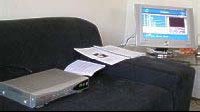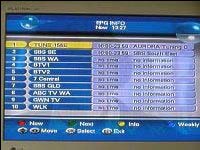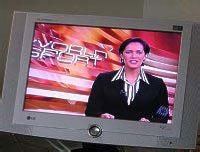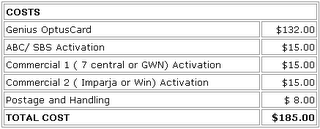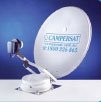Videosat Pty Ltd is an Australian company with 20 years’ experience in supplying
satellite systems for
free to air TV and radio. Originally supplying satellite systems to remote area viewers, the last four years has seen
Videosat introduce it’s popular
Campersat range of satellite systems and accessories for caravans and motor homes.
Wally Shand, General Manager of
Videosat, has been aware of the need for a suitable solution for Australia’s wandering travellers and has designed a range of systems that are reliable and user-friendly.
Satellite television is available anywhere in Australia in superb
digital quality. Most seasoned travellers would have experienced the difficulties involved in trying to access local television using their terrestrial aerial. With a
Campersat satellite system, catching up on the news, following your favourite soap or watching the football has never been easier. For those subscribers of Pay TV by satellite,
Campersat systems fully support connection of
Pay TV equipment.
Striving to meet a range of budgets and needs,
Campersat now includes a rooftop and portable range. The newest and most exciting addition to the
Campersat range is the fully automated
Campersat AutoSeek. Manufactured to Australian conditions, this roof mounted system will
automatically locate the satellite from anywhere in Australia. Alongside the
AutoSeek is the
Campersat EasySeek, originally known as
Campersat Premium and winner of the 2002
CCIA “
Most Innovative Product of the Year” Award. The
EasySeek features mounting equipment that is fixed permanently to the roof of a motor home or caravan with interior controls for easy operation. Both rooftop products feature a 90cm dish.
Campersat’s portable range includes the Executive and the Compact. The Executive features a sturdy tripod mount with adjustable legs suitable for level or sloping ground. Other features include durable brass locking handles, in-built bulls eye level for easy handling and anchor tie down ring for dish stability in high winds. The Compact is Campersat’s most economical model and features a low profile, sturdy, fixable tripod mount.
The portable range is supplied with a 75cm dish, which is suitable for reception over most of Australia with the convenient size for travel and includes the same high quality, one cable easily removable digital test meter as the roof top easy seek. Both systems can operate with up to 100 metres of cable, and are easy to carry, set up and stow.
All Campersat systems are supplied as complete system packages and include rooftop or portable mounting option, cabling, satellite receiver, free to air smart card and digital test meter. Further to Videosat’s goal to make it’s Campersat systems as user-friendly as possible, an instruction manual and laminated guide to finding the satellite are supplied. Also featured is labelling with markings for all parts that are relevant when locating the satellite.
Videosat’s friendly staff is happy to help you find the system that best suits your needs. We are available to answer questions, provide information and after sales support.
Call Videosat today on 02 9482 3100 or 1800 226 865.
Visit our website at
www.campersat.com.au
 Mobile Satellite Broadband is here now!
Mobile Satellite Broadband is here now!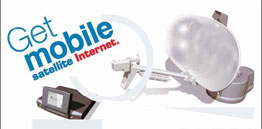



 It can all be unbolted fortransport, but the unit is small and light enough for that to be unnecessary unless space is at a premium. A big benefit of reading the Installation and Operation Manual in conjunction with the KOSCom 1600A Digital Satellite Receiver Operation Manual is that 'Techo Speak' is blown out of the water with plain instructions, simple graphics and a portable, laminated onesheet guide to 'Finding the Satellite' and 'Satellite Signal LocationMaps'.
It can all be unbolted fortransport, but the unit is small and light enough for that to be unnecessary unless space is at a premium. A big benefit of reading the Installation and Operation Manual in conjunction with the KOSCom 1600A Digital Satellite Receiver Operation Manual is that 'Techo Speak' is blown out of the water with plain instructions, simple graphics and a portable, laminated onesheet guide to 'Finding the Satellite' and 'Satellite Signal LocationMaps'. When we shut the system down and moved the dish some distance to fairly uneven ground we were not so smart. Most of the 10 minute set-up time went on fine tuning the dish elevation and Azimuth angle to the satellite. Patience pays.
When we shut the system down and moved the dish some distance to fairly uneven ground we were not so smart. Most of the 10 minute set-up time went on fine tuning the dish elevation and Azimuth angle to the satellite. Patience pays.
 Read off Elevation (Tilt) = In Melbourne 44deg. Sydney is 50 deg. It is a ‘right hand thread’ but, the Campersat elevation marker can be set up for left-handers. Now get the test meter on the back of the dish backbone buzzing by pressing the two yellow buttons on its face simultaneously. You get a visual read out too in red bars. Read off Direction (Azimuth) = InMelbourne 17deg to the right (east) of north. Rotate the Dish to get the maximum signal from the test meter. Lightly lock the Dish and press Channel 1OK on the Campersat remote.
Read off Elevation (Tilt) = In Melbourne 44deg. Sydney is 50 deg. It is a ‘right hand thread’ but, the Campersat elevation marker can be set up for left-handers. Now get the test meter on the back of the dish backbone buzzing by pressing the two yellow buttons on its face simultaneously. You get a visual read out too in red bars. Read off Direction (Azimuth) = InMelbourne 17deg to the right (east) of north. Rotate the Dish to get the maximum signal from the test meter. Lightly lock the Dish and press Channel 1OK on the Campersat remote.
